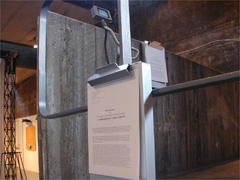| http://www.bureauit.org/data/BANGBANG.html |
 |
||
|
The bureau of inverse technology (BIT) is a "private information agency,"
a semi-anonymous, semiautonomous cadre of engineers, who create nonstandard
products, such as the Suicide Box (1997), which captured video
clips when it detected motion (it was positioned below the Golden
Gate Bridge). BIT products implicitly call attention to the veil of
an anonymous, corporate bureaucracy, which profits from the popular
perception that technology is not authored--hence no one is responsible
for it; nothing can be done about it. BANGBANG is a network of audio and video capture and transmission devices. Although there are significant technical achievements to enable real-time transmissions, the important factor from a public perspective is the context--both in terms of placement and system. Video capture based on a sound trigger was at least hinted at in, say, Robert Rauschenberg's Open Score during the 1969 9 Evenings: Theater and Engineering (see Telematics Timeline, 60s). The BANGBANG network, however, is a classic information system--meaning neutral. It transmits the video and audio capture whether triggered by gunshots in a war zone or by a car backfiring on a busy street in New York City. It is always incumbent on the user, in an information-saturated environment, including an art gallery, to analyze sources and differentiate between apparently similar products (despite corporate marketing). Nodes in the BANGBANG network include: http://www.bureauit.org/data/bangbang/kills.html http://www.bureauit.org/data/bangbang/san.html http://www.bureauit.org/data/bangbang/ftb.html http://www.bureauit.org/data/bangbang/crow.html http://www.bureauit.org/data/ho_bway.html http://www.bureauit.org/data/bangbang/newc.html BANGBANG is also a network of human agents, who help install and maintain the BANGBANG transmitters. As a network, it does broadcast, with no direct feedback loop. At the same time it is conceptually open-ended, available to any individual. It also delivers such surprising content that it undermines our ingrained notion of a broadcast network as something that produces filler in between commercials, beyond any individual control, except via random, repetitive clicking of the remote. http://www.bureauit.org/data/BANGBANG.html |



